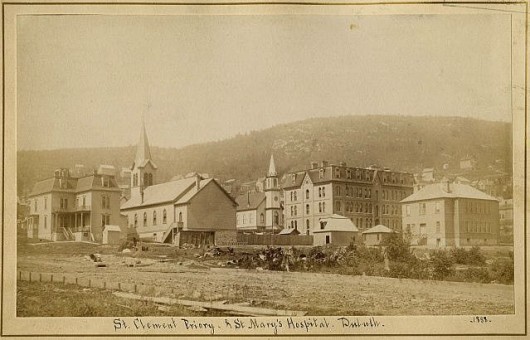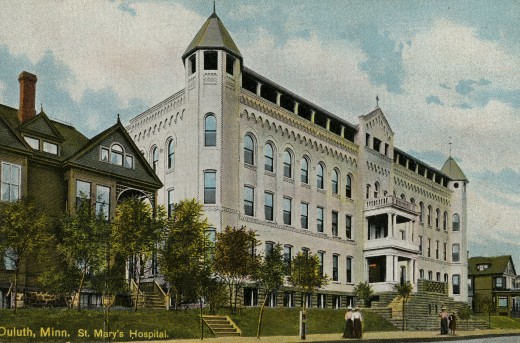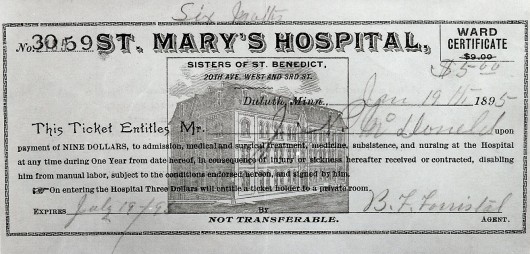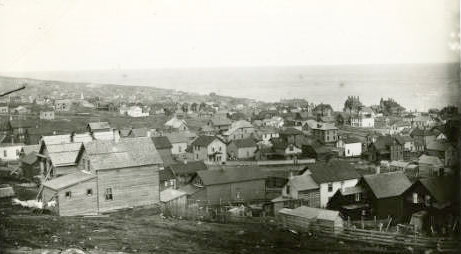
The buildings in this picture were located in Duluth’s West End, at 20th Avenue West and Third Street. The second structure from the right, with four stories and an imposing mansard roof, became the first St. Mary’s Hospital, which predated the establishment of St. Scholastica Monastery as an independent Community.
It began with Abbot Alexius Edelbrock of St. John’s Monastery in Collegeville, Minnesota. He had a dream of establishing an independent abbey of monks in Duluth, and to that end had purchased several lots in the West End. He sent a crew of monks and the monastic architect from St. John’s, Father Gregory Steil, to construct a church, school, and seminary. Bricks from the St. John’s brickyard were sent to Duluth by the trainload, and by the end of 1887 the construction was nearing completion.
Due to some internal problems at St. John’s, Abbot Alexius soon realized that this was not the time for a new monastic foundation. Instead, he suggested to Mother Scholastica Kerst of St. Benedict’s Convent in St. Joseph that the Sisters should convert the seminary building into a hospital. (The church and school became the Benedictine parish of St. Clement.) And so the first St. Mary’s Hospital opened in 1888.

Four years later in 1892, and with the support of the new Diocese’s first bishop, James McGolrick, the Duluth Sisters became an independent Community, under the leadership of Mother Scholastica Kerst. In 1894, they planned to build a motherhouse and school at Fifth Avenue East and Third Street, but after the foundations were completed they were unable to raise money to complete the project. In 1897, Bishop McGolrick suggested relocating St. Mary’s Hospital from the west end to that site. Although the country was in the middle of a major depression that followed the Panic of 1897, the Sisters were able to raise funds to complete the project, and the new building opened in 1898.
The old hospital in the West End became the first St. James Catholic Orphanage, and then in 1911 the first St. Ann’s Home for the Aged. In 1958 the original hospital was demolished and became a parking lot for a highrise apartment building.

St. Mary’s offered an early form of affordable health insurance to men working in lumber camps, which Sister Amata Mackett sold on her camp visits while dispensing medical advice, Scripture passages, and pies. For a few dollars a year, the ticket holder would be entitled to free health care; however, the back of the ticket warned that “insanity, contagious, infectious, venereal diseases, or injuries existing before the date of this ticket, or arising from the use of intoxicating drink, or fighting, are excluded from the Hospital Benefits under this contract.” The sale of these tickets helped keep the hospital afloat financially.

The new St. Mary’s could house 200 patients, twice as many as the original St. Mary’s. Even so, as Duluth’s population rose so did the demand for medical services, and in 1912, an extension with an additional 75 beds was added. Over the decades, additions were made along Third Street in 1921 and 1957. In 1967 the yellow-brick east wing (on the right of the picture above) was razed to make way for a new east wing, which opened in 1969. In 1997, St. Mary’s merged with the Duluth Clinic and Miller-Dwan Medical Center to form the SMDC Health System.

In 2004, Essentia Health was formed as the parent corporation of the SMDC and the Benedictine Health System, one of the Sisters’ health care ministries. In 2008, Innovis Health of Fargo joined Essentia Health, and the hospitals and clinics operated by the Benedictine Health System were transferred to Essentia Community Hospitals and Clinics, while its long-term care facilities remained under the Benedictine Health System; this includes the Benedictine Health Center in Duluth.
Do you have all that straight? Neither do I. Suffice it to say that today, Essentia Health sprawls over much of what was once Duluth’s Ashtabula Heights neighborhood, and provides health care services for residents of northern Minnesota, the Dakotas, northern Wisconsin, and the western Upper Peninsula of Michigan. What began as a seminary for monks is now a well-run medical center that provides every service except transplants.

When we compare this photo, taken from Ashtabula Heights in the 1880s, with the view of Essentia from the waterfront, we see that health care in Duluth under the auspices of the Sisters of St. Scholastica Monastery has come a long way. It nevertheless retains the Benedictine values instilled in that first hospital in 1888 in the West End: quality care, hospitality to all, respect for patients and employees, justice and equal treatment for each person regardless of circumstances, and stewardship of resources and of the earth.
